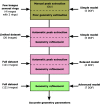New tools for calibrating diffraction setups
- PMID: 32153298
- PMCID: PMC7842211
- DOI: 10.1107/S1600577520000776
New tools for calibrating diffraction setups
Abstract
New calibration tools in the pyFAI suite for processing scattering experiments acquired with area detectors are presented. These include a new graphical user interface for calibrating the detector position in a scattering experiment performed with a fixed large area detector, as well as a library to be used in Jupyter notebooks for calibrating the motion of a detector on a goniometer arm (or any other moving table) to perform diffraction experiments.
Keywords: geometry calibration; goniometers; moving detectors; pair distribution function; powder diffraction; translation tables.
Figures










References
-
- Boesecke, P. (2007). J. Appl. Cryst. 40, s423–s427.
-
- Boudet, N., Berar, J.-F., Blanquart, L., Breugon, P., Caillot, B., Clemens, J.-C., Koudobine, I., Delpierre, P., Mouget, C., Potheau, R. & Valin, I. (2003). Nucl. Instrum. Methods Phys. Res. A, 510, 41–44.
-
- Chupas, P. J., Qiu, X., Hanson, J. C., Lee, P. L., Grey, C. P. & Billinge, S. J. L. (2003). J. Appl. Cryst. 36, 1342–1347.
Grants and funding
LinkOut - more resources
Full Text Sources
Other Literature Sources

